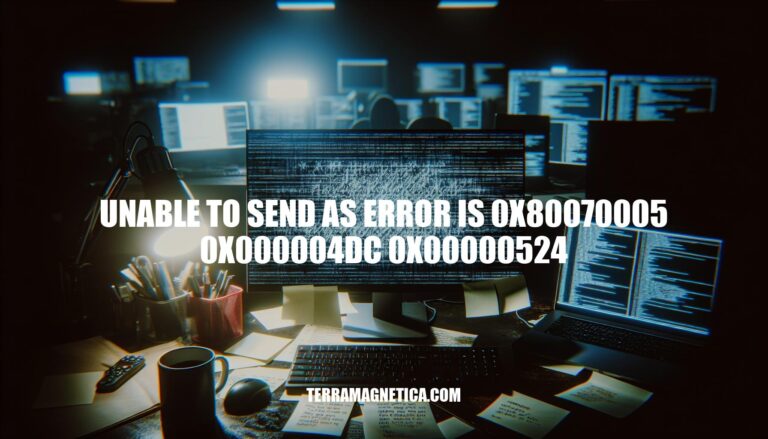


The error codes 0x80070005, 0x000004dc, and 0x00000524 often appear in shared mailbox scenarios, indicating permission issues. This error is common when users attempt to send emails from a shared mailbox without the necessary “Send As” or “Send on Behalf” permissions. Understanding and resolving this error is crucial for maintaining smooth email communication in collaborative environments.
The error code 0x80070005-0x000004dc-0x00000524 typically occurs in Microsoft Outlook when attempting to send an email from a shared mailbox. This error indicates that the user does not have the necessary permissions to send emails on behalf of the shared mailbox.
Here’s a detailed breakdown of the error codes:
Lack of “Send As” Permission: The most common cause is that the user has not been granted the “Send As” permission on the shared mailbox. This permission allows a user to send emails as if they are the shared mailbox itself.
Incorrect Configuration: Sometimes, the shared mailbox might be incorrectly configured, or the permissions might not have been properly applied. This can happen if the permissions were set up incorrectly in the Exchange Admin Center or via PowerShell.
Hidden Mailbox: If the shared mailbox is hidden from the Global Address List (GAL), it can cause issues with sending emails from that mailbox.
Outlook Client Issues: The error might occur if there are issues with the Outlook client itself, such as corrupted profiles or outdated software. In some cases, the error does not occur when using Outlook Web Access (OWA), indicating a client-specific issue.
Grant “Send As” Permission: Ensure that the user has the “Send As” permission for the shared mailbox. This can be done using the Exchange Admin Center or via PowerShell with the following command:
Add-RecipientPermission -Identity "Shared Mailbox" -Trustee "User" -AccessRights SendAs
Check Configuration: Verify that the shared mailbox is correctly configured and that the permissions are properly applied.
Unhide Mailbox: If the mailbox is hidden from the GAL, unhide it to ensure proper functionality.
Update and Repair Outlook: Ensure that the Outlook client is up to date and repair any corrupted profiles.
By addressing these specific conditions, you can resolve the error and ensure that emails can be sent from the shared mailbox without issues.
The error codes 0x80070005, 0x000004dc, and 0x00000524 often indicate issues related to permissions and configuration when trying to send emails from a shared mailbox. Here are some common causes:
Permission Issues:
Configuration Errors:
These steps should help in diagnosing and resolving the error. If the issue persists, further investigation into the specific environment and configurations might be necessary.
Here are the steps to troubleshoot and resolve the error ‘unable to send as error is 0x80070005 0x000004dc 0x00000524′:
Check Permissions:
Assign Send As Permission:
Add-RecipientPermission -Identity "Shared Mailbox" -Trustee "User" -AccessRights SendAs
Restart Outlook:
Check for Full Access:
Run Outlook in Safe Mode:
outlook.exe /safe
Update Outlook:
Re-add Shared Mailbox:
File > Account Settings > Account Settings > Change > More Settings > Advanced > Add
These steps should help resolve the issue. If the problem persists, further investigation into the specific environment may be needed.
Proper Mailbox Configuration:
Regular Permission Audits:
User Training:
System Updates:
Backup and Recovery:
These steps should help prevent encountering the error in the future.
Follow these steps:
If the issue persists, investigate further into the specific environment. Proper mailbox configuration, regular permission audits, user training, system updates, and backup and recovery are essential to prevent encountering this error in the future.